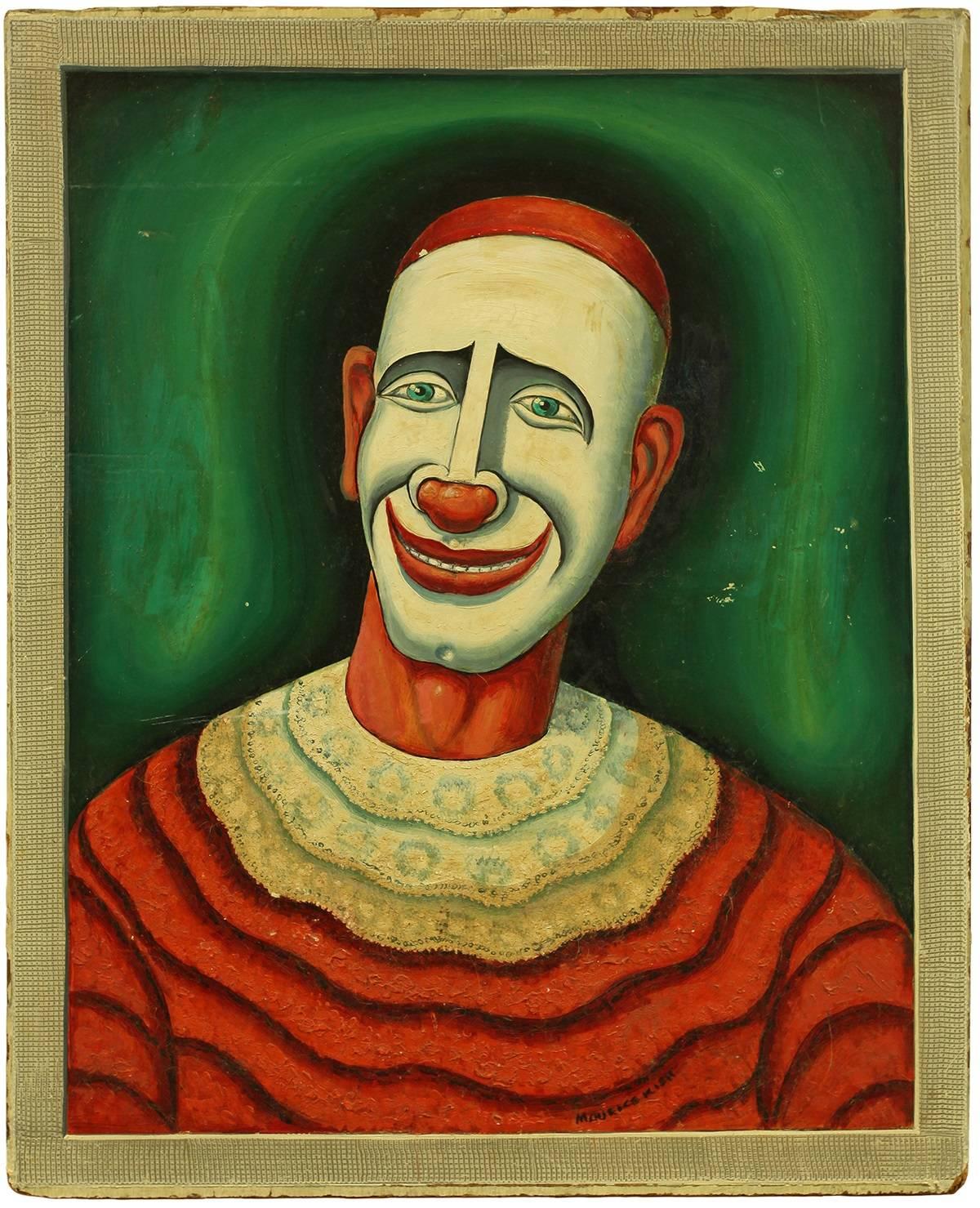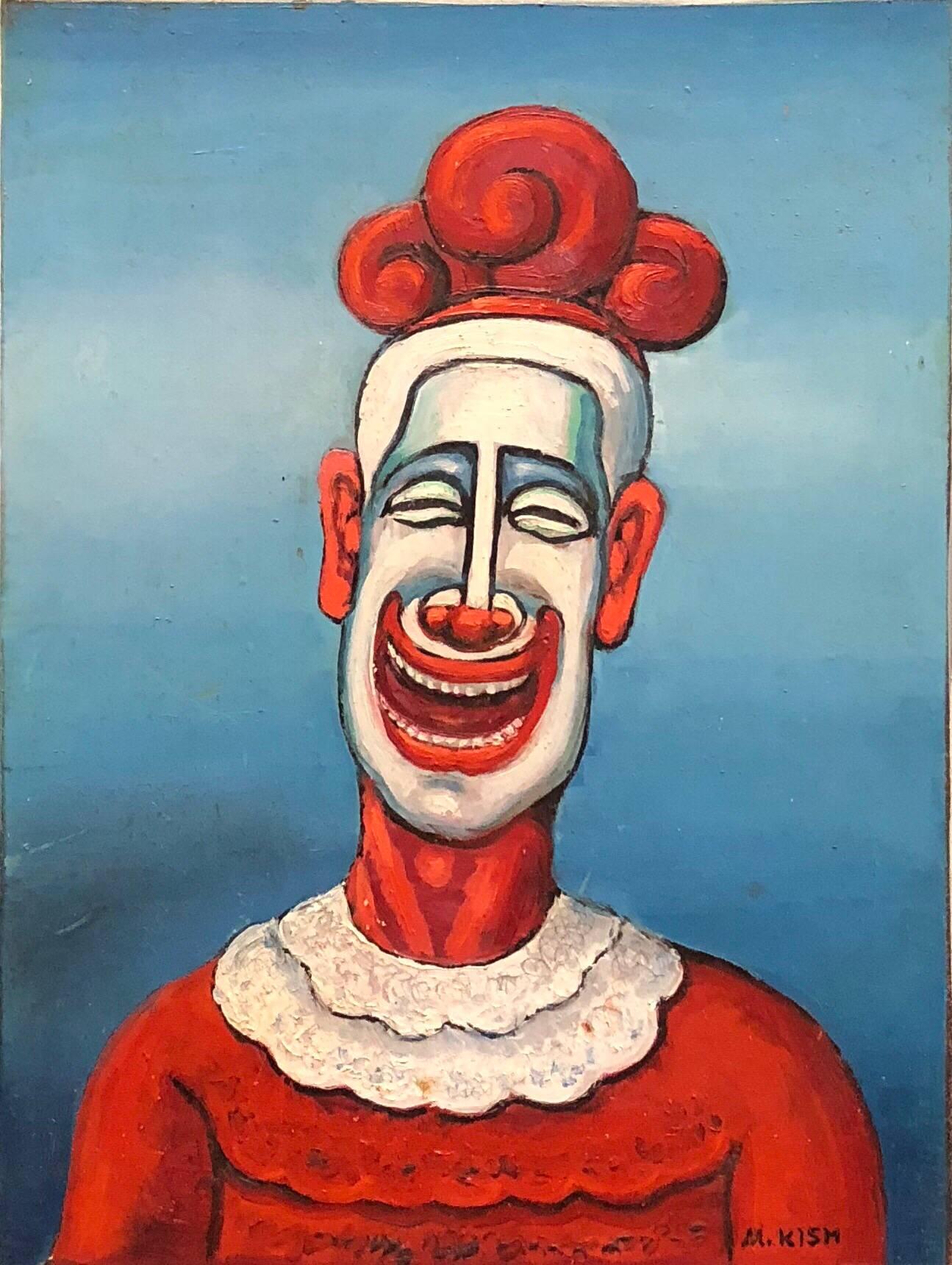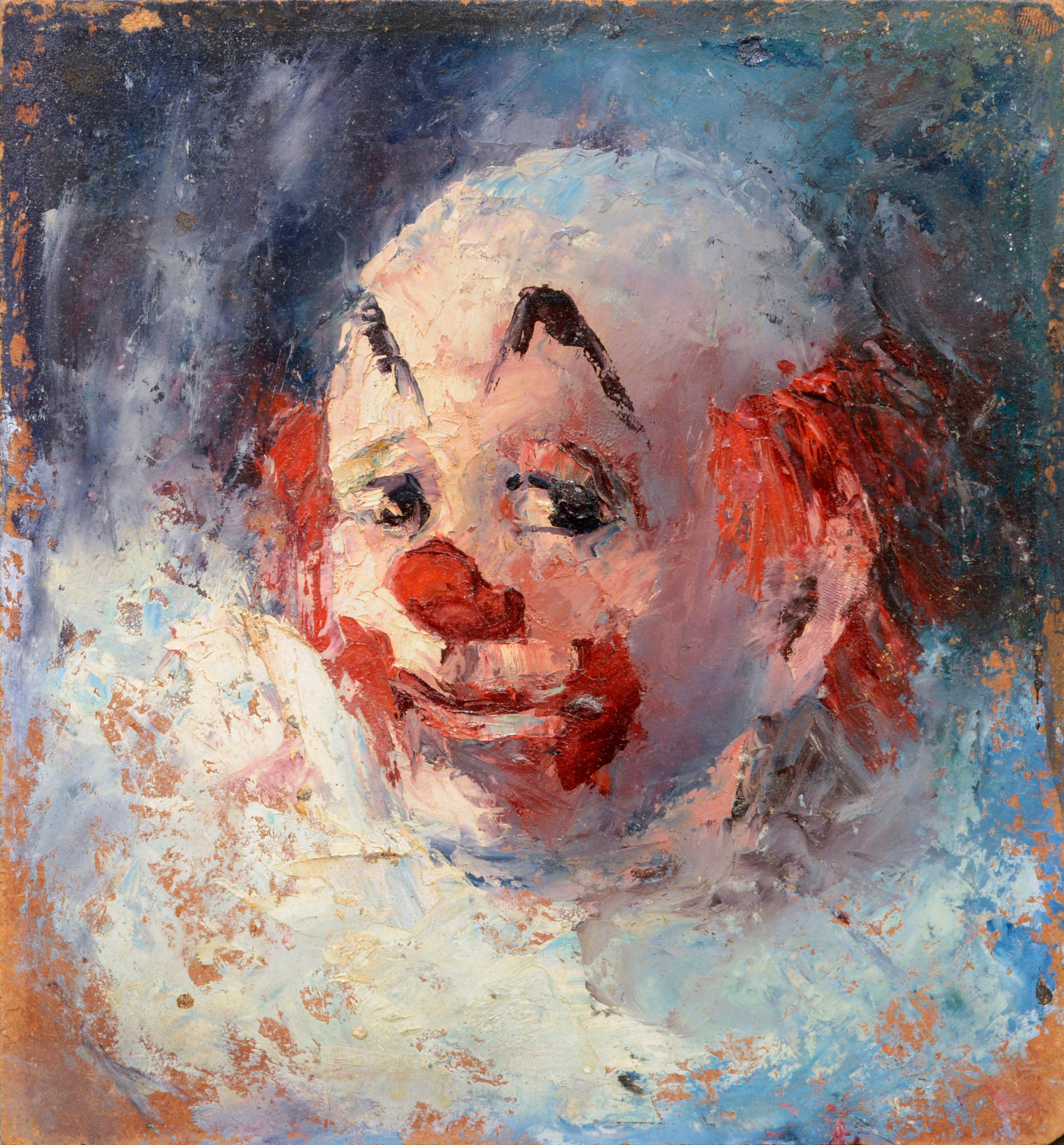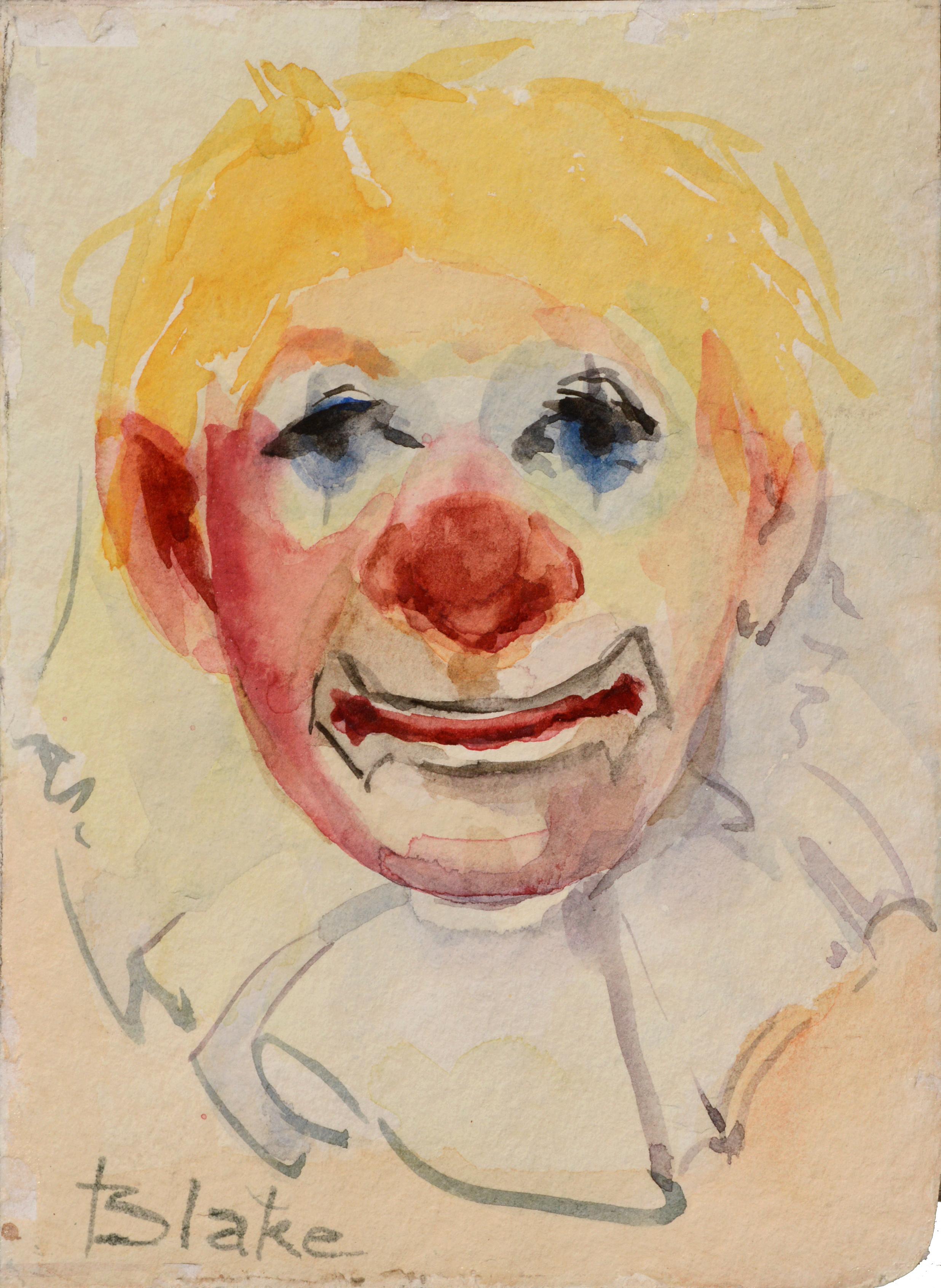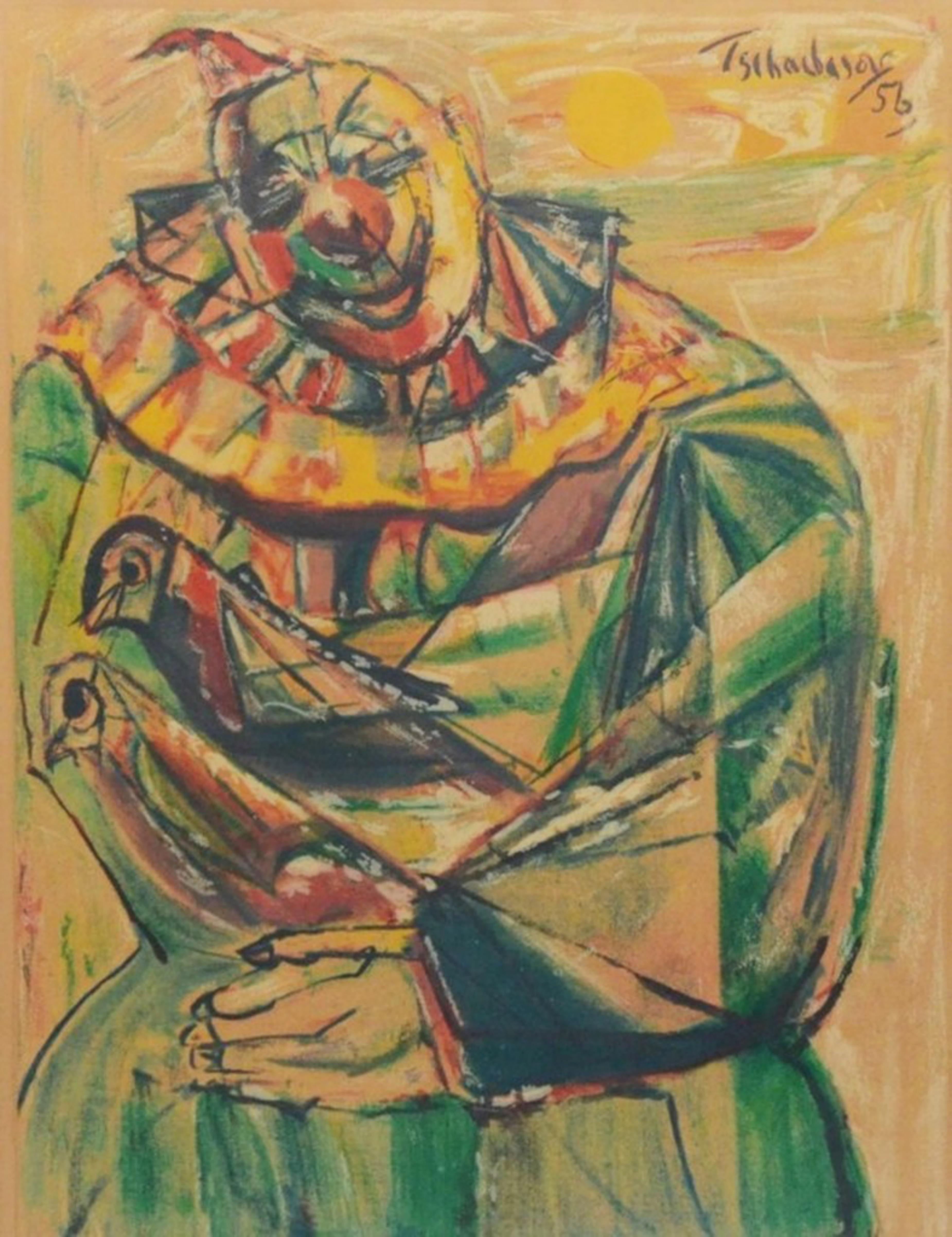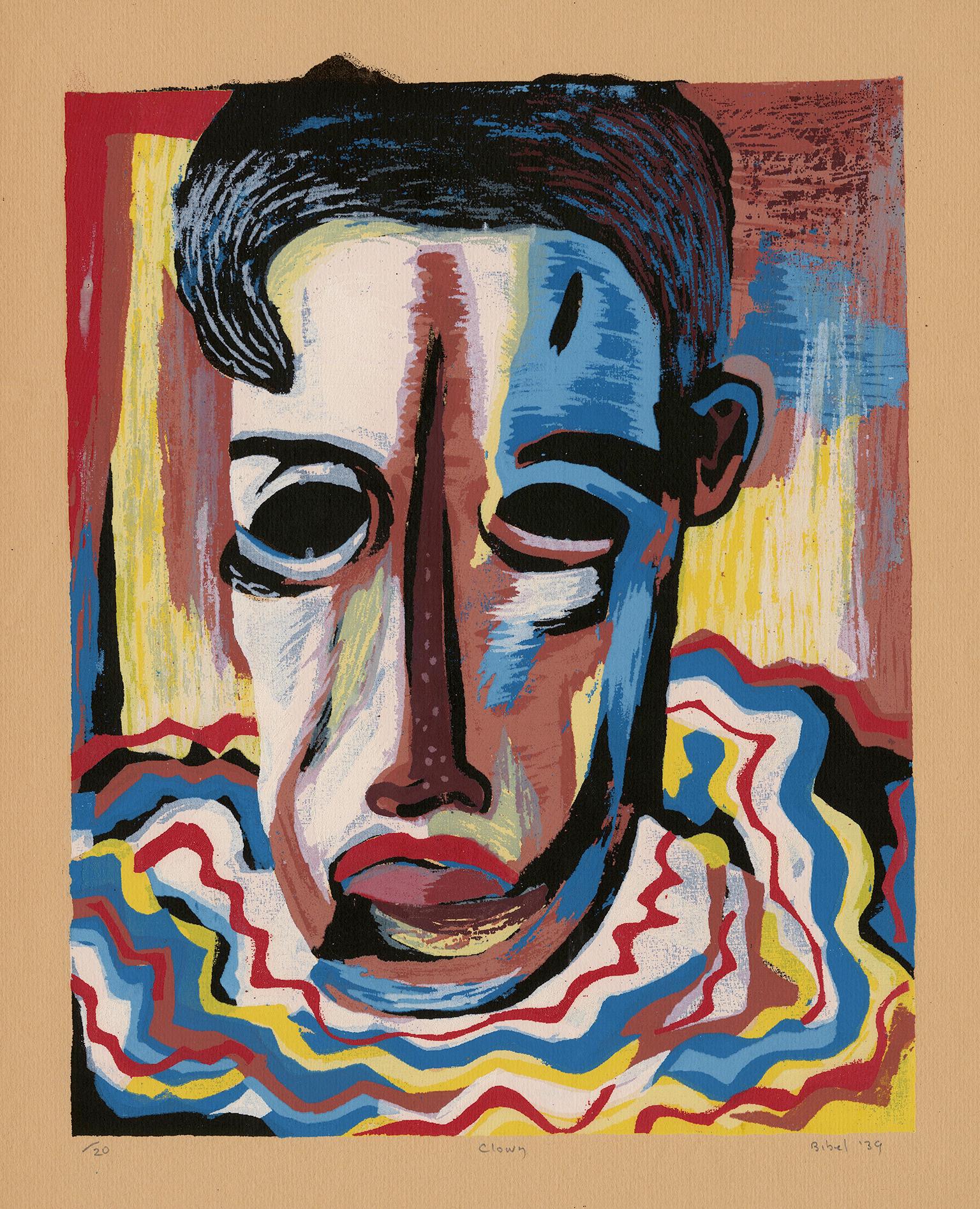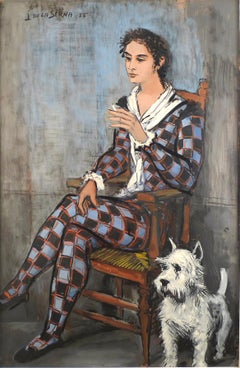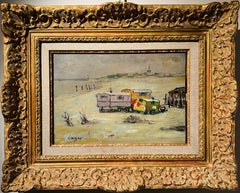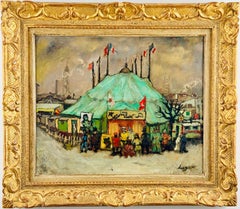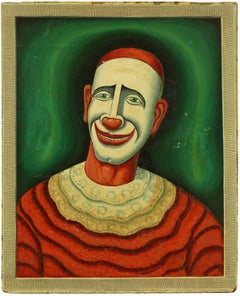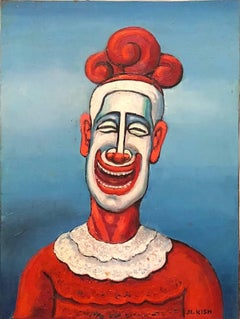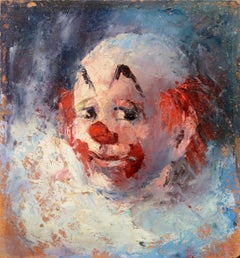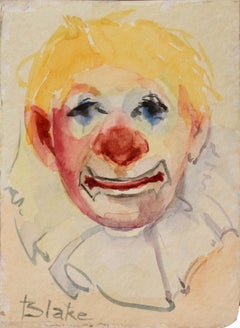Items Similar to "The Clown", 20th Century Gouache on Cardboard by Spanish Artist Celso Lagar
Want more images or videos?
Request additional images or videos from the seller
1 of 2
Celso Lagar"The Clown", 20th Century Gouache on Cardboard by Spanish Artist Celso Lagar1952
1952
Price Upon Request
Price Upon Request
Price Upon Request
Price Upon Request
Price Upon Request
Price Upon Request
Price Upon Request
Price Upon Request
Price Upon Request
Price Upon Request
Shipping
Retrieving quote...The 1stDibs Promise:
Authenticity Guarantee,
Money-Back Guarantee,
24-Hour Cancellation
About the Item
CELSO LAGAR
Spanish, 1891 - 1966
THE CLOWN
signed and dated "Lagar 52" (lower right)
gouache on cardboard
10-5/8 x 8 inches (27 x 20.5 cm.)
PROVENANCE
Private French Collector
Celso Lagar Arroyo (Ciudad Rodrigo, 1891 - Seville, 1966) was an expressionist Spanish painter of the first generation of the School of Paris, where he lived most of his life. He was influenced by avant-gardes of all kinds, such as cubism and fovism. He painted mainly landscapes and still lifes. From a personal point of view, he is a depressive person and completely dependent on his wife, the French sculptor Hortense Begué.
From his native Ciudad Rodrigo, he went to Madrid to be part of the workshop of one of the best sculptors of the moment, Miguel Blay. During 1910 and 1911 he visited Barcelona. Later he studied sculpture in Paris in 1911 advised by Blay, where he met Joseph Bernard, his friend Amedeo Modigliani and his future wife, the French sculptor, Hortense Begué. It will be precisely at that moment when, gradually, he leaves the sculpture in favor of painting.
The outbreak of the First World War will mean, in the life and work of Celso Lagar, the beginning of a new stage. He remained in Barcelona during the war, where he achieved a certain recognition, which allows him to return to Paris. In 1919 he settled permanently in France. His time until the end of the 30s, is the moment of his greatest splendor of the artist. He manages to exhibit his works in the best Parisian galleries, his production is abundant and constant. Both in his residence in Paris and in his rooms, since 1928, in Normandy he will develop an artistic production with very specific themes: still lifes, Spanish reminiscences, landscapes and his celebrated circus scenes. After the period of avant-garde influences of all kinds (Cubism, Fauvism, Vibrationism, Biologism, Simultaneism, Ultraist, ...), Celso Lagar will find his own path marked mainly by Goyesque and Picasian inspiration. Critical and public recognition increases.
With the onset of World War II, its golden age will end. Lagar and Hortense are forced to take refuge in the French Pyrenees amid very difficult living conditions. His return after the liberation of Paris did not have such an impact. Lagar will continue with the same themes and techniques before the war but the public is already looking for new content. Gradually, success fades and economic hardships affect the couple.
At this time around the year 1950, his wife Hortense enters the hospital Broca and in 1955 dies. Lagar falls into a deep depression and will enter the psychiatric hospital of Sainte Anne. His artistic work ends completely. At that time, by court order, two auctions of the works that remained in his workshop are held, to pay for his stay in the asylum. In October 1964 he returned to Spain living in Seville with a sister until his death on September 6, 1966.
His paintings are found in numerous museums throughout Europe, such as: La Rochelle, Goya Museum in Castres, Honfleur (France), Petit-Palais de Geneva, Reina Sofía National Art Center Museum, Casa Lis de Salamanca, Carmen Thyssen Museum ( Malaga) and in prestigious collections such as Crane Kallman (London) or Zborowski (Paris).
He was illustrator of several magazines, among them, the Spanish Magazine Nova, Un enemic del Poble and Troços.
- Creator:Celso Lagar (1891 - 1966, Spanish)
- Creation Year:1952
- Dimensions:Height: 10.63 in (27 cm)Width: 8.27 in (21 cm)
- Medium:
- Movement & Style:
- Period:
- Condition:
- Gallery Location:Madrid, ES
- Reference Number:1stDibs: LU1281110393232
Celso Lagar
Celso Lagar Arroyo (Ciudad Rodrigo, 1891 - Seville, 1966) was an expressionist Spanish painter of the first generation of the School of Paris, where he lived most of his life. He was influenced by avant-gardes of all kinds, such as cubism and fovism. He painted mainly landscapes and still lives. From his native Ciudad Rodrigo, he went to Madrid to be part of the workshop of one of the best sculptors of the moment, Miguel Blay. During 1910 and 1911 he visited Barcelona. Later he studied sculpture in Paris in 1911 advised by Blay, where he met Joseph Bernard, his friend Amedeo Modigliani and his future wife, the French sculptor, Hortense Begué. It will be precisely at that moment when, gradually, he leaves the sculpture in favor of painting. The outbreak of the First World War will mean, in the life and work of Celso Lagar, the beginning of a new stage. He remained in Barcelona during the war, where he achieved a certain recognition, which allows him to return to Paris. In 1919 he settled permanently in France. His time until the end of the 30s, is the moment of his greatest splendor of the artist. He manages to exhibit his works in the best Parisian galleries, his production is abundant and constant. Both in his residence in Paris and in his rooms, since 1928, in Normandy he will develop an artistic production with very specific themes: still lifes, Spanish reminiscences, landscapes and his celebrated circus scenes. After the period of avant-garde influences of all kinds (Cubism, Fauvism, Vibrationism, Biologism, Simultaneism, Ultraist, ...), Celso Lagar will find his own path marked mainly by Goyesque and Picasian inspiration. Critical and public recognition increases. With the onset of World War II, its golden age will end. Lagar and Hortense are forced to take refuge in the French Pyrenees amid very difficult living conditions. His return after the liberation of Paris did not have such an impact. Lagar will continue with the same themes and techniques before the war but the public is already looking for new content. Gradually, success fades and economic hardships affect the couple. At this time around the year 1950, his wife Hortense enters the hospital Broca and in 1955 dies. Lagar falls into a deep depression and will enter the psychiatric hospital of Sainte Anne. His artistic work ends completely. At that time, by court order, two auctions of the works that remained in his workshop are held, to pay for his stay in the asylum. In October 1964 he returned to Spain living in Seville with a sister until his death on September 6, 1966. His paintings are found in numerous museums throughout Europe, such as: La Rochelle, Goya Museum in Castres, Honfleur (France), Petit-Palais de Geneva, Reina Sofía National Art Center Museum, Casa Lis de Salamanca, Carmen Thyssen Museum ( Malaga) and in prestigious collections such as Crane Kallman (London) or Zborowski (Paris).
About the Seller
5.0
Vetted Professional Seller
Every seller passes strict standards for authenticity and reliability
Established in 1977
1stDibs seller since 2019
21 sales on 1stDibs
Typical response time: 1 hour
- ShippingRetrieving quote...Shipping from: Madrid, Spain
- Return Policy
Authenticity Guarantee
In the unlikely event there’s an issue with an item’s authenticity, contact us within 1 year for a full refund. DetailsMoney-Back Guarantee
If your item is not as described, is damaged in transit, or does not arrive, contact us within 7 days for a full refund. Details24-Hour Cancellation
You have a 24-hour grace period in which to reconsider your purchase, with no questions asked.Vetted Professional Sellers
Our world-class sellers must adhere to strict standards for service and quality, maintaining the integrity of our listings.Price-Match Guarantee
If you find that a seller listed the same item for a lower price elsewhere, we’ll match it.Trusted Global Delivery
Our best-in-class carrier network provides specialized shipping options worldwide, including custom delivery.More From This Seller
View All"Harlequin and his dog", 20th Century oil on cardbard by Ismael de la Serna
By Ismael de la Serna
Located in Madrid, ES
ISMAEL GONZÁLEZ DE LA SERNA
Spanish, 1898 - 1968
HARLEQUIN AND HIS DOG
Signed and dated I. de la Serna, 1955
Oil on cardboard
42 X 27-1/2 i...
Category
1950s Symbolist Portrait Paintings
Materials
Oil, Cardboard
"Les Roulottes", 20th Century Oil on Wood Panel by Spanish Artist Celso Lagar
By Celso Lagar
Located in Madrid, ES
CELSO LAGAR
Spanish, 1891 - 1966
LES ROULOTTES
signed "Lagar" (lower left)
oil on wood panel
9-1/2 x 13 inches (24 x 33 cm.)
framed: 17-1/8 x 21-1/2 inches (43.5 x 54.5 cm.)
PROVEN...
Category
1930s Fauvist Figurative Paintings
Materials
Oil, Wood Panel
Francisco Bores, Sans titre
By Francisco Bores
Located in Madrid, ES
FRANCISCO BORES
Spanish, 1898 - 1972
SANS TITRE
signed and dated "Borès 42" (lower left)
oil on panel
13-3/4 x 10-5/8 inches (35 x 27 cm.)
framed: 19 x 15-3/4 inches (48 x 40 cm.)
BIBLIOGRAPHY:
Francisco Bores, Reasoned Catalogue, Volume I - Painting 1917-1944, Museo Nacional Centro de Arte Reina Sofía, Madrid, 2003, nº 1942 / 63, reproduced in p. 494
PROVENANCE
Carmen Bores Collection, Francisco Bores daughter
Private Collection, Madrid
Francisco Bores López (Madrid, May 5, 1898 - Paris, May 10, 1972) was a Spanish painter of the so-called New School of Paris.
His artistic training originated both in the Cecilio Pla painting academy, where he met Pancho Cossío, Manuel Ángeles Ortiz or Joaquín Peinado, and in the literary gatherings in Madrid related to ultraism.
At this time he made engravings and woodcuts for a large number of magazines such as Horizonte, Cruz y Raya, Index, Revista de Occidente. In 1922 he participated in the National Exhibition of Fine Arts.
In 1925 he participated in the first exhibition of the Iberian Artists Society. The limited success of this exhibition pushes him to go to Paris. In this city he shared a studio with the Spanish painter Pancho Cossío and also met Picasso and Juan Gris.
In 1927 he held his first solo exhibition in Paris. From this moment on, Bores integrates himself into the Parisian artistic environment where he will live practically his entire life. In 1928, his first exhibition in a gallery in the United States, in 1930 he exhibited again, within a group exhibition at the Museum of Modern Art in New York.
In the following years, he continued exhibiting in different galleries in Paris, such as the Georges Petit Gallery, the Bernheim Gallery and the Vavin Raspail Gallery. He also participates in several group exhibitions, highlighting the Exhibition of Contemporary Spanish Art...
Category
1940s Fauvist Interior Paintings
Materials
Oil, Panel
Pavillon de Cirque
By Celso Lagar
Located in Madrid, ES
CELSO LAGAR
Spanish, 1891 - 1966
PAVILLON DE CIRQUE
signed "Lagar" (lower right)
oil on canvas
15 x 18 inches (38 x 46 cm.)
framed: 21-1/2 x 24-1/2 inches (54 x 62 cm.)
NOTE:
THIS W...
Category
1930s Fauvist Figurative Paintings
Materials
Oil, Canvas
"Les Fumeurs", 20th Century Oil on Cardboard by Spanish Artists Francisco Bores
By Francisco Bores
Located in Madrid, ES
FRANCISCO BORES
Spanish, 1898 - 1972
LES FUMEURS
signed & dated "Borès 35" (lower right)
titled in pencil "Les Fumeurs", unfinished sketch (head), signed & dated "Bores 36" (on the reverse)
oil on cardboard
10-5/8 x 13-3/4 inches (27 x 35 cm.)
framed: 15-1/2 x 18-1/2 inches (39.5 x 47 cm.)
NOTE:
THIS WORK IS ACCOMPANIED BY A CERTIFICATE OF AUTHENTICITY ISSUED BY “ARCHIVO FRANCISCO BORES”.
BIBLIOGRAPHY:
Francisco Bores, Reasoned Catalogue, Volume I - Painting 1917-1944, Museo Nacional Centro de Arte Reina Sofia, Madrid, 2003, n° 1935 / 49, reproduced in color p. 281
PROVENANCE
Carmen Bores Collection, Francisco Bores daughter
Francisco Bores López (Madrid, May 5, 1898 - Paris, May 10, 1972) was a Spanish painter of the so-called New School of Paris.
His artistic training originated both in the Cecilio Pla painting academy, where he met Pancho Cossío, Manuel Ángeles Ortiz...
Category
1930s Cubist Figurative Paintings
Materials
Oil, Cardboard
Ramoneur IV
By Eduardo Arroyo
Located in Madrid, ES
EDUARDO ARROYO
Spanish, 1937 - 2018
RAMONEUR IV
signed, dated and numbered "ARROYO / 1982 / 1/6" (on the side of the neck)
"MAGISA" foundry seal (on the side of the neck)
bronze and ...
Category
1980s Cubist Figurative Sculptures
Materials
Bronze
You May Also Like
Clown, Early 20th Century Playful Oil Painting on Board
By Maurice Kish
Located in Surfside, FL
This portrait of a clown by Maurice Kish is part from a series of carnival figures, circus clowns and carousel horses and riders that he did in the 30s and 40s. The artist uses a vibrant color palette and controlled brushstrokes to depict the subject in a realistic way.
The imagery of Maurice Kish (1895-1987), whether factories or carousels, reliably subverts expectations. His vision hovers just around the unraveling edge of things, where what is solid and clear becomes ambiguous. He is fascinated, often delighted, by the falling apart. This unexpected, fresh perspective results in oddly affecting pictures of a now long-gone New York.
Born Moishe in a town called Dvinsk, Russia (what is now Daugavpils, Latvia), Kish came with his family to New York when he was in his teens. The family settled in Brownsville, and for the rest of Kish’s life Brooklyn remained his home, though he moved from one neighborhood to another. He was close to his parents, who recognized his talent and supported his desire to become an artist.
Kish attended the National Academy of Design as well as Cooper Union. His fellow students included many other immigrants and children of immigrants who were particularly receptive to the Modernism coming from Europe. As his career progressed, Kish himself applied different strains of Modernism to different purposes. For him, the story was held above all else.
For years, Kish used the skills he acquired in art school to earn his living at a Manhattan glass...
Category
Early 20th Century Modern Portrait Paintings
Materials
Oil, Board
Clown, Modernist Oil Painting on Board WPA Artist
By Maurice Kish
Located in Surfside, FL
This portrait of a clown by Maurice Kish is part from a series of carnival figures, circus clowns and carousel horses and riders that he did in the 30s and 40s. The artist uses a vib...
Category
Early 20th Century Modern Portrait Paintings
Materials
Oil, Board
1960s Clown Portrait #4
By Marjorie May Blake
Located in Soquel, CA
Portrait of a clown in three quarter view, with expressive brushstrokes and use of color by Marjorie Blake (1920-1994). Unsigned, but was purchased with...
Category
1960s American Impressionist Portrait Paintings
Materials
Oil, Fiberboard
Clown Portrait #8
By Marjorie May Blake
Located in Soquel, CA
Watercolor portrait of a clown by Marjorie Blake (American, 1920-1994). Signed "Blake" in the lower left corner. Unframed.
Marjorie May Gulley Blake wa...
Category
1960s American Impressionist Figurative Drawings and Watercolors
Materials
Paper, Watercolor
Mid Century Modern Clown print, hand signed 144/250 Russian born American artist
By Nahum Tschacbasov
Located in New York, NY
Nahum Tschacbasov
Mid Century Modern Clown, 1956
Lithograph
Signed, dated and numbered 144/250 in graphite on the front
34 x 27.5 inches
Unframed, affixed to matting
Published by American Color Slide Co, Ltd., New York
Terrific uncommon vintage signed, numbered and dated mid Century modern lithograph from this interesting and distinctive -and undervalued Russian American artist. Highly collectible clown...
Category
Mid-20th Century Expressionist Abstract Prints
Materials
Lithograph, Pencil
'Clown' — WPA American Expressionism
By Leon Bibel
Located in Myrtle Beach, SC
Leon Bibel, 'Clown', color serigraph, 1939, edition 20. Signed, dated, titled, and numbered '/20' in pencil. A fine, richly-inked, painterly impression, with fresh colors, on buff la...
Category
1930s American Modern Figurative Prints
Materials
Screen
More Ways To Browse
The Clown
Vintage Clown Sign
French Clown
Malaga Painting
Portrait Of Clown
Modigliani Portrait
Circus Clown Art
Vintage Circus Clown
Vintage Clowns Clowns Circuses
Clown Sculpture
Dior Clown
Antique Portrait Painting Of Man
Unknown Woman Portrait
Portrait Young Girl Painting
Gilded Portrait
Oil Painting And Sir
Pair Of Portrait Painting
19th Century Portrait Of A Woman
